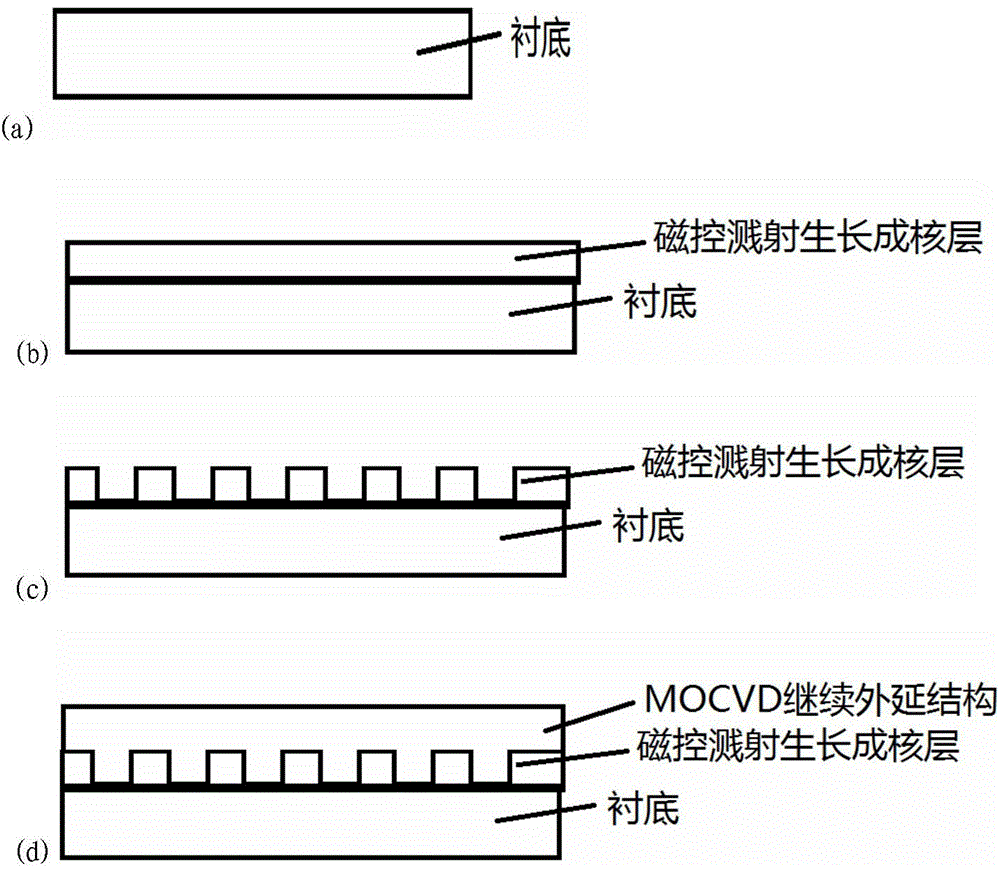Method for growing photoelectric material and device through two-step method
A technology of optoelectronic materials and devices, which is applied in the direction of electrical components, semiconductor devices, metal material coating technology, etc., can solve the problems of crystal quality improvement and quality control, and achieve the reduction of XRD diffraction crystal surface half-width and photoelectric conversion efficiency The effect of improving and increasing production capacity
- Summary
- Abstract
- Description
- Claims
- Application Information
AI Technical Summary
Problems solved by technology
Method used
Image
Examples
Embodiment 1
[0024] First, the existing sapphire PSS substrate material is used to deposit AlN material in the magnetron sputtering equipment, the deposition thickness is 25nm, and then the substrate material deposited with the AlN buffer layer is transferred to the MOCVD equipment for high temperature treatment, and the processing temperature is 1100 degrees. After the pressure is 200mbar and the processing time is 3min (the optimized result), the high temperature deposition of non-doped GaN, N-type doped GaN, stress release layer, multiple quantum well layer, electron blocking layer and P-type GaN structure LED is started. As a comparison, the same PSS substrate is directly epitaxially grown in MOCVD, first depositing AlN with a thickness of 25nm, then 1100 degrees, pressure 200mbar, and after 3 minutes of processing time, high-temperature deposition of non-doped GaN, N-type doped GaN, stress release layer, multi-quantum well layer, electron blocking layer and P-type GaN structure LED. A...
Embodiment 2
[0026] Use the existing sapphire PSS substrate material to deposit AlN material in the magnetron sputtering equipment, the deposition thickness is 15nm, and then pattern the PSS substrate material deposited with the AlN buffer layer as figure 2 The structure shown in the figure is then transferred to MOCVD equipment for high-temperature treatment. The treatment temperature is 1100 degrees, the pressure is 200mbar, and the treatment time is 2.5 minutes (optimized results). After that, high-temperature deposition of non-doped GaN, N-type doped GaN, and stress release layer begins , multi-quantum well layer, electron blocking layer and P-type GaN structure LED. For comparison, on the same PSS sapphire substrate, epitaxial growth is directly carried out in MOCVD. First, AlN is deposited with a thickness of 15nm, and then 1100 degrees, a pressure of 200mbar, and a treatment time of 2.5 minutes. GaN, stress release layer, multi-quantum well layer, electron blocking layer and P-type...
Embodiment 3
[0028] Use the existing sapphire planar substrate material to deposit AlN material in the magnetron sputtering equipment, the deposition thickness is 25nm, and then pattern the substrate material deposited with the AlN buffer layer as follows: image 3The structure shown in the figure is then transferred to MOCVD equipment for high-temperature treatment. The treatment temperature is 1100 degrees, the pressure is 200mbar, and the treatment time is 3 minutes (optimized results). After that, high-temperature deposition of non-doped GaN, N-type doped GaN, and stress release layer, Multi-quantum well layer, electron blocking layer and LED with P-type GaN structure. As a comparison, epitaxial growth is directly carried out in MOCVD on the same sapphire flat substrate. First, AlN is deposited with a thickness of 25nm, and then 1100 degrees, a pressure of 200mbar, and a high temperature deposition of non-doped GaN and N-type doped GaN. , stress release layer, multi-quantum well layer,...
PUM
| Property | Measurement | Unit |
|---|---|---|
| thickness | aaaaa | aaaaa |
| thickness | aaaaa | aaaaa |
Abstract
Description
Claims
Application Information
 Login to View More
Login to View More - R&D
- Intellectual Property
- Life Sciences
- Materials
- Tech Scout
- Unparalleled Data Quality
- Higher Quality Content
- 60% Fewer Hallucinations
Browse by: Latest US Patents, China's latest patents, Technical Efficacy Thesaurus, Application Domain, Technology Topic, Popular Technical Reports.
© 2025 PatSnap. All rights reserved.Legal|Privacy policy|Modern Slavery Act Transparency Statement|Sitemap|About US| Contact US: help@patsnap.com



